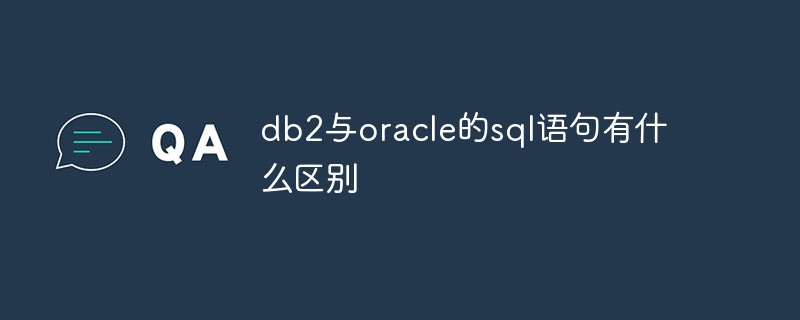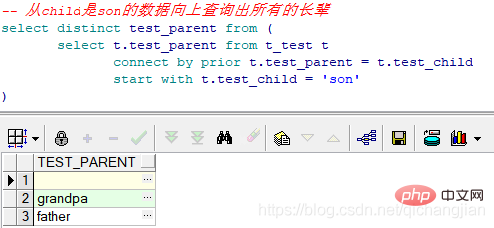What is the difference between db2 and oracle sql statements?
Difference: 1. db2 uses "create table a like b" to create a similar table, oracle uses "create table a as select * from b"; 2. db2 uses varchar type conversion, oracle uses the "to_char" function Convert.

The operating environment of this tutorial: Windows 10 system, Oracle 11g version, Dell G3 computer.
What is the difference between db2 and oracle sql statements
1. Create similar table syntax
Oracle : create table a as select * from b; DB2 : create table a like b; (8版本有效,9版本无效) create table new_a as select col1,col2... from a definition only
2. Quickly clear large table syntax
Oracle : truncate table a; DB2 : alter table a active not logged initially with empty table;
3. Get the first N data syntax
Oracle : select * from a where rownum <h4 id="strong-Get-the-system-time-syntax-strong"><strong>4. Get the system time syntax</strong></h4><pre class="brush:php;toolbar:false">Oracle : select sysdate from dual; DB2 : select current timestamp from sysibm.sysdummy1;
5. Different ways to convert null values
Oracle : select col1,col2,nvl(col3,'0') from tablename; (判断col3字段是否为空,不为空就输出原来的数值,为空就输出0) DB2 : select col1,col2,value(col3,'0') from tablename; (mysql和Db2可以使用Coalesce(col3,'0')函数来实现上述功能)
Coalesce() function
这个函数主要用来进行空值处理,其参数格式如下: COALESCE ( expression,value1,value2……,valuen) COALESCE()函数的第一个参数expression为待检测的表达式,而其后的参数个数不定。 COALESCE()函数将会返回包括expression在内的所有参数中的第一个非空表达式。 如果expression不为空值则返回expression; 否则判断value1是否是空值,如果value1不为空值则返回value1; 否则判断value2是否是空值,如果value2不为空值则返回value2; ……以此类推, 如果所有的表达式都为空值,则返回NULL。
6. Type conversion Different methods
oracle : select to_char(sysdate,'YYYY-MM-DD HH24:MI:SS') from dual; DB2 : select varchar(current timestamp) from sysibm.sysdummy1;
Analysis:
Oracle数据类型改变函数:to_char()、to_date()、to_number()等;
如果仅仅取年,月,日等,可以用
to_char(sysdate, 'YYYY'),
to_char('MM') ,
to_char('DD')取得。
只取年月日TRUNC(SYSDATE)。
取时分秒TO_CHAR(SYSDATE,'HH24:MI:SS')。
DB2数据类型改变函数:char()、varchar()、int()、date()、time()等;
取得年,月,日等的写法:
YEAR(current timestamp),
MONTH(current timestamp),
DAY(current timestamp),
HOUR(current timestamp),
MINUTE(current timestamp),
SECOND(current timestamp),
MICROSECOND(current timestamp),
只取年月日可以用
DATE(current timestamp),
取时分秒
TIME(current timestamp)。
Char()是定长字符串(1-255),varchar()为非定长字符串(1-32672)日期,
时间形态变为字符形态:
char(current date),
char(current time)
将字符串转换成日期或时间形态:
TIMESTAMP('2002-10-2012:00:00'),
DATE('2002-10-20'),
DATE('10/20/2002'),
TIME('12:00:00')Currently DB2 V8 also supports to_char and to_date, V9 version has added to_number
7. String conversion Different date methods (To_Number/cast)
Oracle:
select to_number('123') from dual;
select cast('123' as integer) from dual;
DB2 :
select cast('123' as integer) from sysibm.sysdummy1;
select cast(current time as char(8)) from sysibm.sysdummy1;8. Subquery
Oracle: 直接用子查询 Db2:WITH语句 WITH a1 AS(SELECT max(id) AS aa1 FROM test )SELECT id ,aa1 FROM test ,a1
9. Recursive query (hierarchical query )
Oracle递归查询:CONNECT BY PRIOR ... START WITH ... DB2 递归查询:DB2较难理解,要WITH一个虚拟表
Oracle:
//从child是son的数据向上查询出所有的长辈select distinct test_parent from ( select t.test_parent from t_test t connect by prior t.test_parent = t.test_child start with t.test_child = 'son' )

Learn more: Oracle hierarchical query (recursive query): start with …connect by prior and level keyword
DB2:
// Db2递归查询写法with par_test(test_child,test_parent) as( select test_child,test_parent from t_test where child='grandchild' -- 设置递归起点 union all select t.test_child,t.test_parent from par_test pt,t_test t where pt.test_parent = t.test_child ----递归的方向为从子向父)select distinct test_parent from par_test


As shown above, query all grandchild starting from grandchild For the parent node of For:
| ##father |
| grandpa |
比较大的差别: 1. char大小对比 Oracle: char 2000 DB2 : char 254 2. 日期类型 Oracle: date datetime DB2 :date(日期) time(时间)timestamp(日期时间)
11. About rowId
Oracle中它是由数据库唯一产生的,在程序中可以获得 DB2 在V8版本才有此功能
12.decode method
Oracle: decode方法(decode(条件,值1,翻译值1,值2,翻译值2,...,值n,翻译值n,缺省值)) 【函数用法在下边有链接】 或者 case语句 DB2: 只有case表达式 示例语句: select id,name, case when integer(flag)=0 then '假' when integer(flag)=1 then '真' else '异常' end from test 或者 select id,name, case integer(flag) when 0 then '假' when 1 then '真' else '异常' end from test
Recommended tutorial: "Oracle Video Tutorial"
The above is the detailed content of What is the difference between db2 and oracle sql statements?. For more information, please follow other related articles on the PHP Chinese website!

Hot AI Tools

Undresser.AI Undress
AI-powered app for creating realistic nude photos

AI Clothes Remover
Online AI tool for removing clothes from photos.

Undress AI Tool
Undress images for free

Clothoff.io
AI clothes remover

AI Hentai Generator
Generate AI Hentai for free.

Hot Article

Hot Tools

Notepad++7.3.1
Easy-to-use and free code editor

SublimeText3 Chinese version
Chinese version, very easy to use

Zend Studio 13.0.1
Powerful PHP integrated development environment

Dreamweaver CS6
Visual web development tools

SublimeText3 Mac version
God-level code editing software (SublimeText3)

Hot Topics
 1376
1376
 52
52
 How to import oracle database
Apr 11, 2025 pm 08:06 PM
How to import oracle database
Apr 11, 2025 pm 08:06 PM
Data import method: 1. Use the SQLLoader utility: prepare data files, create control files, and run SQLLoader; 2. Use the IMP/EXP tool: export data, import data. Tip: 1. Recommended SQL*Loader for big data sets; 2. The target table should exist and the column definition matches; 3. After importing, data integrity needs to be verified.
 How to create a table in oracle
Apr 11, 2025 pm 08:00 PM
How to create a table in oracle
Apr 11, 2025 pm 08:00 PM
Creating an Oracle table involves the following steps: Use the CREATE TABLE syntax to specify table names, column names, data types, constraints, and default values. The table name should be concise and descriptive, and should not exceed 30 characters. The column name should be descriptive, and the data type specifies the data type stored in the column. The NOT NULL constraint ensures that null values are not allowed in the column, and the DEFAULT clause specifies the default values for the column. PRIMARY KEY Constraints to identify the unique record of the table. FOREIGN KEY constraint specifies that the column in the table refers to the primary key in another table. See the creation of the sample table students, which contains primary keys, unique constraints, and default values.
 How to check tablespace size of oracle
Apr 11, 2025 pm 08:15 PM
How to check tablespace size of oracle
Apr 11, 2025 pm 08:15 PM
To query the Oracle tablespace size, follow the following steps: Determine the tablespace name by running the query: SELECT tablespace_name FROM dba_tablespaces; Query the tablespace size by running the query: SELECT sum(bytes) AS total_size, sum(bytes_free) AS available_space, sum(bytes) - sum(bytes_free) AS used_space FROM dba_data_files WHERE tablespace_
 How to add table fields to oracle
Apr 11, 2025 pm 07:30 PM
How to add table fields to oracle
Apr 11, 2025 pm 07:30 PM
Use the ALTER TABLE statement, the specific syntax is as follows: ALTER TABLE table_name ADD column_name data_type [constraint-clause]. Where: table_name is the table name, column_name is the field name, data_type is the data type, and constraint-clause is an optional constraint. Example: ALTER TABLE employees ADD email VARCHAR2(100) Add an email field to the employees table.
 What to do if the oracle can't be opened
Apr 11, 2025 pm 10:06 PM
What to do if the oracle can't be opened
Apr 11, 2025 pm 10:06 PM
Solutions to Oracle cannot be opened include: 1. Start the database service; 2. Start the listener; 3. Check port conflicts; 4. Set environment variables correctly; 5. Make sure the firewall or antivirus software does not block the connection; 6. Check whether the server is closed; 7. Use RMAN to recover corrupt files; 8. Check whether the TNS service name is correct; 9. Check network connection; 10. Reinstall Oracle software.
 How to solve garbled code in oracle
Apr 11, 2025 pm 10:09 PM
How to solve garbled code in oracle
Apr 11, 2025 pm 10:09 PM
Oracle garbled problems can be solved by checking the database character set to ensure they match the data. Set the client character set to match the database. Convert data or modify column character sets to match database character sets. Use Unicode character sets and avoid multibyte character sets. Check that the language settings of the database and client are correct.
 How to re-query oracle
Apr 11, 2025 pm 07:33 PM
How to re-query oracle
Apr 11, 2025 pm 07:33 PM
Oracle provides multiple deduplication query methods: The DISTINCT keyword returns a unique value for each column. The GROUP BY clause groups the results and returns a non-repetitive value for each group. The UNIQUE keyword is used to create an index containing only unique rows, and querying the index will automatically deduplicate. The ROW_NUMBER() function assigns unique numbers and filters out results that contain only line 1. The MIN() or MAX() function returns non-repetitive values of a numeric column. The INTERSECT operator returns the common values of the two result sets (no duplicates).
 How to encrypt oracle view
Apr 11, 2025 pm 08:30 PM
How to encrypt oracle view
Apr 11, 2025 pm 08:30 PM
Oracle View Encryption allows you to encrypt data in the view, thereby enhancing the security of sensitive information. The steps include: 1) creating the master encryption key (MEk); 2) creating an encrypted view, specifying the view and MEk to be encrypted; 3) authorizing users to access the encrypted view. How encrypted views work: When a user querys for an encrypted view, Oracle uses MEk to decrypt data, ensuring that only authorized users can access readable data.




